#larus
Explore tagged Tumblr posts
Text

bwahh
2K notes
·
View notes
Text

european herring gull (larus argentatus) and black-headed gull (chroicocephalus ridibundus), ireland
#charadriiformes#laridae#larus#herring gull#european herring gull#chroicocephalus#black headed gull#gulls#seabirds#birds#birdwatching#bird photography#display flight
677 notes
·
View notes
Text


My humble bday offering for @oriiduckko & @shandzii 🙏(◕u◕)
#ocean idiots#oc#original character#friends character#oriiduckko#shandzii#khora#larus#art#birthday gift#bday#gift art#HAPPY BIRTHDAYY#EXPLODES EVERYOEN!!!!#C:
2K notes
·
View notes
Text
wait da minute... PAUSE-

578 notes
·
View notes
Text

Callie's favorite water boy
Also, quick update for those un aware, I'm gonna have to shave Poptart bald :/ (plus rework his whole entire structure or sum idk teehee) enjoy these other doodles as compensation.




#splatoon#callie cuttlefish#splatoon 3#callie splatoon#squid sisters#dedf1sh#acht splatoon#calf1sh#captain 3#splatmeshi#larus#splatoon oc#poptart#anjanath#mhs2#imma TWEAK TF OUT if another one of these damn markers dry out 🙂
174 notes
·
View notes
Text

Franklin Island Light, Muscongus Bay, Friendship, Maine. Once the lighthouse was automated in 1933, all the structures, save the tower and oil house, were burned. In 1973 U. S. Fish and Wildlife Service took over care of what is now Franklin Island National Wildlife Refuge. It's a popular nesting spot for a number of gull species, as well as eiders, storm petrels and other sea birds. Because of this, the refuge is closed to the public annually from April 1st to July 31st, so the birds can focus on keeping their chicks safe and fed.
#Franklin Island Light#Muscongus Bay#Friendship#Maine.#Franklin Island Lighthouse#lighthouse#maine#maine lighthouse#gulls#seagull#seagulls#laughing gull#herring gull#great black-backed gull#Leucophaeus atricilla#Larus smithsonianus#Larus marinus#Larus#illustration#art#drawing#maine artist#knox county
93 notes
·
View notes
Text


Photo source
Map source
70 notes
·
View notes
Text
courage has come to me to post fanart











larus and mariza: @shandzii
Bloomy and Dr Phantasmo: @fluffffpillow
springdad (fluffy William afton hehe): @skeletoninthemelonland
Delta: @el-pada
#rose’s art#springdad au#ocean idiots#bloomy#Im currently begging my friends to play pressure so I don’t die alone ha#Delta#Mariza#Larus#might’ve forgotten a few tags#fnaf#springtrap
21 notes
·
View notes
Text
Literary Waterfolkology: Some Historical and Folkloric Similarities in Shandzii's merfolk animatics and more

Edited "A Mermaid and a Warrior" by Georges Antoine Rochegrosse (1859-1938). It seems quite familiar... (´ಠ∀ಠ`)
Another analysis of fictional waterfolk, this tide of time for one of my favorite literary stories featuring waterfolk who are referred to as "Ocean Idiots". It is a quite popular* collaborative work made by multiple authors. Mariza is the sea serpent-person and oceanic deity, Samira is the lunar deity, Larus is the aerial deity, and Indra is the preceding sea serpent-person and oceanic deity before Mariza, all of them by Shandzii. Delta is the shark-person by El-Pada who also created Delta's pirate crew if I am right. Heather the waterfolk hunter or butcher is by Melodyofthevoid. Please dive into the original works before reading, for they are fin-tastic, sublime, and ultra super shell-tacular. If one could do so, please do so. All gifs here are excerpts from Shandzii's animations that were available here. The screenshots of some artworks are all property of the respective artists aside from all the other depictions which have entered the public domain. According to what I have read on their respective blogs on answered ask entries, the artists are fine with their art being used as long as proper credit is given and encourage fan-works as long as the usage is not something in utterly troubled waters. I only display their art if I require them to show a claim that I am making, basically I have had to use them as sources sometimes. Please sea the originals and dive into the works. Here, I solely dive into waterfolklogy as always. What I note are only similarities I noticed, nothing may have been fin-tended and does not mean to serve as a saying that these are "references".
SHALL WE DIVE INTO....
THE GREAT SEA?
SEA-HAW (YEEHAW) AYE AYE FELLOW FIN-DIVIDUAL
Mariza's transformation from a mortal to a shapeshifting humanoid sea serpent-person deity has some folkloric similarities in the "Ship in a Bottle" animatic upon slaying Indra. Many waterpeople were human before in folklore, yet transformed through some means such as curses like Mariza.

Above: Screenshot of Mariza in the "She doesn't need grass" animatic by shandzii.
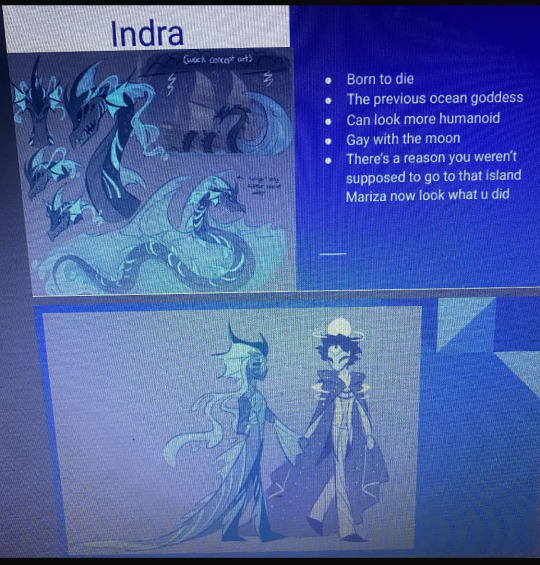
Above: Indra and Samira art by shandzii in the "Ocean Idiots for Idiots" slideshow by melodyofthevoid on pages 14-15
Transformed Mariza has the ability to transform from her serpentine form to a more humanoid form. Indra is capable of transforming from a entire sea-serpent to a more humanoid appearance. There happen to be plenty waterpeople who would be considered water snake-people like Mariza and Indra. Many of them live both in fresh- and saltwater, thus I will refer to such shrimply as watersnake-people. The closest counterpart to Mariza herself might be a tale of the Passamaquoddy Ne Hwas whose term which may be derived of "niwesq" solely means "spirit" for any supernatural being and it may tell of the Passamaquoddy and Malecite lumpeguin water-people instead. However, this folktale still tells of two freshwater-snake-maidens who once were mortal maidens. One day, they got cursed upon not heeding their mother's warning to not go into a lake at which moment they each possessed their lower halves of serpentine tails according to "The Penguin Book of Mermaids" on page 291. They would make that lake their habitat.
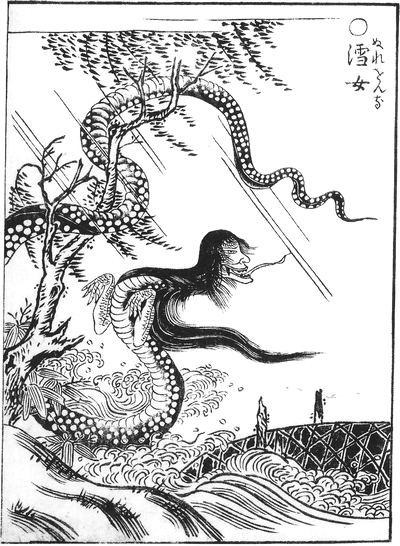
Above: "Nure-onna" by Toriyama Sekien 鳥山石燕 (1712-1788) in the Gazu Hyakki Yakō 画図百鬼夜行.
Some versions of the legend of freshwater-maiden Melusiné say that upon each Saturday, her lower body turned into a serpentine tail from a curse. Usually, she would possess the body of a mortal maiden on other days. There exist the female nagis or naginis and the male nagas in Hinduism who are described as shapeshifting waterfolk, capable of being watersnake-people. "Encyclopedia of Fairies in World Folklore and Mythology" by Theresa Bane on page 241 describes how they tend to "reside at the bottom of lakes, rivers, and the sea in gem encrusted palaces filled with never-ending dance and song". They are able to be partly or fully serpentine. A Russian folktale that is featured in "Russian Fairy Tales" by W. R. S. Ralston tells of complete freshwater-snakes who live underwater and are capable of turning into mortal people ashore. The Wabanaki and Passamaquoddy nodumkanwet or apodumken were waterpeople said to live in waters, possessing piscine or serpentine tails. In Passamaquoddy Bay, they may take the forms of gigantic, fanged water-serpents according to "Mythical Creatures of Maine: Fantastic Beasts from Legend and Folklore" by Christopher Packard on page 87. Nure-onna was a littoral watersnake-maiden from Japanese folklore, appearing as a watersnake with the head of a woman or a water snake-woman with the a humanoid upper body and the lower half of a serpentine tail. Jinja-hime from Japanese folklore was a sea-serpent with the head of a woman. Another Passamaquoddy myth with possible Christian influences according to "The Penguin Book of Mermaids" on page 289 told of two maidens who would go every Sunday to a lake to bathe and perform supposed ill-considered or undesirable acts which caused them to turn into human-headed freshwater-snakes forever. These are all only some finstances.
Mariza can shapeshift into an actual colossal sea serpent-person alongside as in the "Just a Thingy for School :P" animatic. Mariza seems to be capable of turning in tides back and forth from more averagely humanoid-sized to a more colossal sea serpent-person. This size-shifting is present in some folkloric waterpeople. According to "Mythical Creatures of Maine: Fantastic Beasts from Legend and Folklore" by Christopher Packard on page 85, the Native American Malecite and Passamaquoddy lumpeguin water-people could change their size in great amounts from as small to hide under a curled leaf to the size of a large man.
Both Indra and one of Mariza's forms have pointy head-fins which remind me of some ocean-people like the Orcadian sea-trows whose heads looked pointed like the roof of a house according to W. Traill Dennison in "Orkney Folklore: Sea Myths" in "The Scottish Antiquary, Or, Northern Notes & Queries, Volume 5" on page 167 and the Norse hafstramb merman whose head was described with the shape of a peaked helmet in the King's Mirror. Some native depictions of the Melanesian adaro from the Solomon islands in "The Melanesians: Studies in their Anthropology and Folklore" on pages 197 and 259 show the adaro with the head of a swordfish, including the dorsal fin showing from the head's tip.

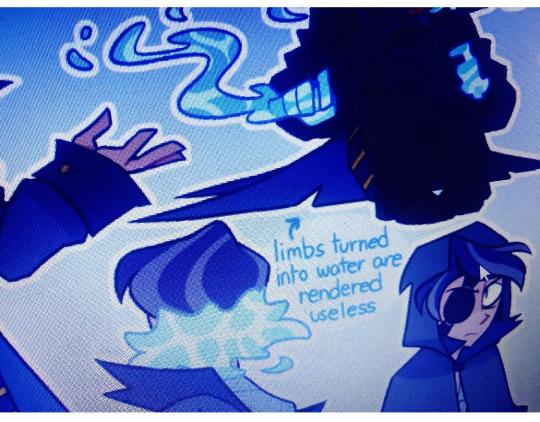
Above: Screenshots of Mariza art details by shandzii.
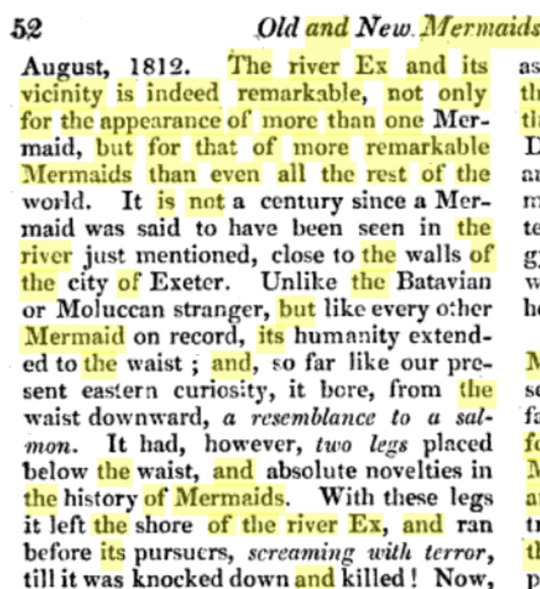
In regards to one of Mariza's usual forms where her legs would be present with a tail alongside, this reminds me of a description of a sighting from Exeter around the River Ex in ca. 1730-1750 as its distribution came from the August of 1823 in "The Asiatic Journal and Monthly Register for British India and its Dependencies Vol. XV" in an article called "Old and New Mermaids". Wherever or whomever this strange sighting originally stemmed from is unknown. "(...) It is not a century since a Mermaid was said to have been seen in the river just mentioned, close to the walls of the city of Exeter... Its humanity extended to the waist and.. it bore from the waist downwards a resemblance to a salmon. It had, however, two legs placed below the waist, and absolute novelties in the history of Mermaids. With these legs it left the shore of the river Ex (...)". Another earlier sighting in Exeter dated from the November of 1737 claimed how "some Fishermen near the city, drawing their Net ashore, a creature of two legs, having human shape, leapt out and ran away very swiftly. (...) Its feet were webbed like a duck’s. It has eyes, nose and mouth, resembling those of a man, only the nose somewhat depressed, and the tail not unlike a salmon’s, only turning up towards its back, and was four feet high". Also of note may be a depiction from the "Oedipus Aegypticus" by Athanisius Kirchner in 1652 of the Assyrian Atargartis aka. Derceto, a humanoid goddess who can be identified with a goddess at Ascalon who possessed piscine attributes.
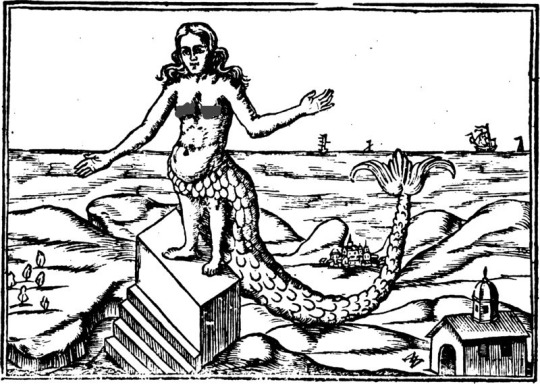
Above: Edited illustration from the "Oedipus Aegypticus" in 1652.
Mariza is also capable of having her limbs turn to an "useless" state of water according to one depiction. I find that this reminds me of the Greek myth of naiad or freshwater-nymph Cyane who was a friend of Persephone in some versions. According to one version, Cyane dissolved into liquid upon seeing Persephone being abducted by Hades. This motif seems somewhat similar to how Mariza may have similar situations where her limbs turn to water upon being distressed.
Indra and Mariza's ability to control the ocean is present in countless waterpeople like Poseidon or Neptune, Triton etc.....
Webbed fin ears themselves that many characters from this literary work bear have their own separate entry in my all-read sea, already. (I have read much in my sea already).
Well, Mariza's hair is also something to take a dive into. Perhaps it may show some similarities with the hair of Sedna in Inuit mythology since her hair was described as entangling the ocean's creatures if she was angry. Inuit shamans would comb her hair, for she herself had no fingers, so that the nautical creatures she withheld from being caught by the people could be free again. Her hair appears to be symbolic for the ocean itself as if her hair was really the ocean where the nautical creatures dwell according to "Orality and Literacy: Reflections Across Disciplines" by Susan Gingell on page 122 and "A Mermaid's Tale: A Personal Search for Love and Lore" by Amanda Adams on pages 129-130. This is somewhat similar to the watery hair motif.


Both Mariza and Delta happened to be pirate waterfolk. During my fin-itial research, the tides of time led me to an unknown legend of piratess Anne Bonny and how she supposedly turned into a mermaid. The legend is from Palma Ceia in Tampa, Florida's Gulf Coast. Mermaid Anne Bonny, wielding a sword, is depicted in the seal of the neighborhood on the left with a stingray-maid called Qualenya on the right. The second depiction of the solo Anne Bonny mermaid above is a bit edited, but this alongside the seal got published on Wikimedia Commons and on Flickr, all released as Public Domain. The description of the solo Anne Bonny depiction states how Anne Bonny, "the most fearsome of all sea hags first appeared in the winter of 1733, the same year Anne Bonny was tossed into the sea upon her conviction for piracy. They say that Anne made a deal with The Sailor’s Devil, that if she allowed him to marry her unborn daughter, he’d grant her eternal life beneath the sea. Ever since, all through the Caribbean and up the Florida coast, Bonny has been luring curious sailors to rocky shallows where their boats are crushed and sunk". Supposedly, what is related comes from a 1800s book on pirates, but its title is not stated in any tide of time which renders this source as rather unreliable, yet it may be a fin-teresting implication.

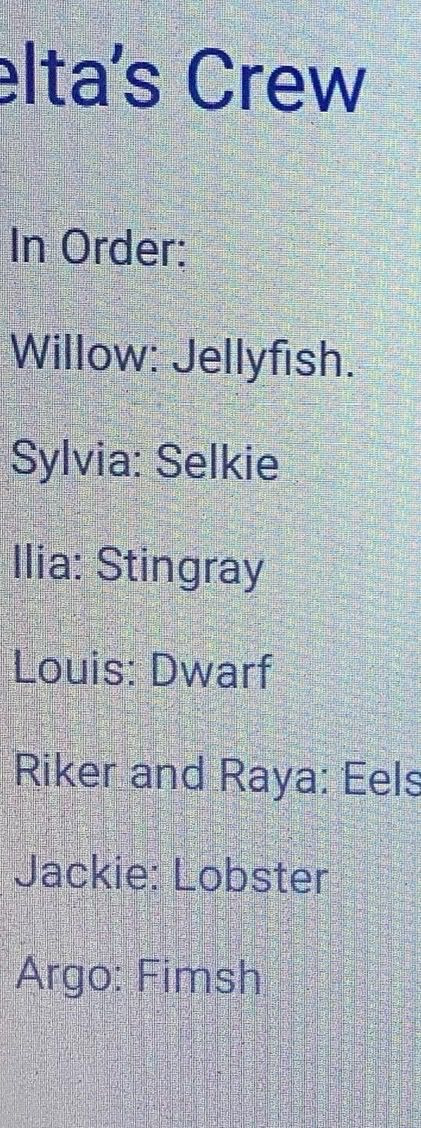
Above: Delta's crew and their respective species as in the "Ocean Idiots for Idiots" slideshow by melodyofthevoid on page 19.
I now shall dive into Delta's pirate crew. The most obvious is the selkie named Sylvia. Sealfolk are Celtic and Norse sea-people who wear sealskins, capable of being seals in the sea and shapeshifting ashore into their humanoid forms, being commonly known as selkies or roane. Without their sealskin, they would usually not be able to shapeshift back into seals and return to the sea.

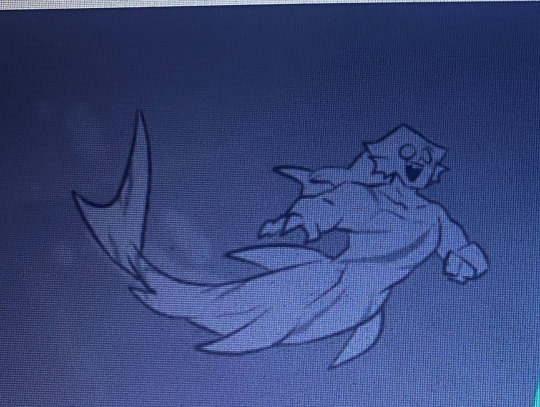
Above: Screenshots of the "She doesn't need Grass" animatic by shandzii.
Delta is capable of transforming into a shark-person. Many shark-people have existed. Dakuwaqa is a Fijian, shapeshifting oceanic deity who was said to be able to shapeshift into multiple forms like a shark or a humanoid. Avatea or Vatea of the mythology of the Cook islands could be a shark-man with his halves of humanoid and aquatic form being split vertically, but some claim he is half-fish or -porpoise alongside. Hawaiian mythology tells of demi-gods such as Nanaue who would be possessing a shark's mouth on their backs, capable of transforming into full shark forms. The Haida Dogfish-people, specifically the Dogfish-Woman, are shapeshifting dog-fish sharks who can assume mortal human forms ashore. Anyhow, Delta's aquatic form also possesses a head tapering into a shark's tail. This is something similar to what I have already done a dive into for the zora of "The Legend of Zelda" in a separate entry, but the Mesopotamian Abgal or Apkallu, sages who were said to have taught knowledge upon mortal humankind, one of the most well-known being named Uanna or Oannes, had such similar depictions with their heads tapering into fishtails. The Melanesian adaro do so alongside since their heads are literally swordfish in aforementioned depictions. Their heads taper into swordfish-tails. Delta's pectoral fins I assume also remind me of some depictions of supposed tritons or sea-satyrs who would have some front legs or fins, this is also something similar to one of Mariza's aforementioned forms.
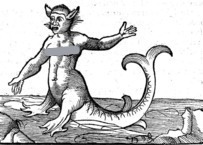
Above: Edited "Monstum Marinum" by Conrad Gessner from his "Historiae animalium" in 1558.

One of Delta's crew named Ilia is a stingray-person like Qualenya who may be from the mythology of the Seminole Native American people. My rather strange sources regarding her primarily fincluded Wikimedia Commons' descriptions for her depictions. Above is an illustration of a 1920s book, supposedly. She can apparently transform from a complete stingray to a more humanoid appearance upon being saved by a boy in a blogspot entry which is the only source I found about her legend, but the source is not reliable alongside. I wrote more about Qualenya in a earlier entry alongside with the Anne Bonny mermaid, consider diving into it.
Jackie from the crew is a lobster-person. Greek and Roman mythology may tell of humanoid sea-deities like tritons or ichthyocentaurs, Phorcys, and Pontus who could bear lobster claw appendages or lobster horns on their heads, possibly including spiky, reddish skin like those of lobsters in Hellenistic-Roman mosaics.

Above: Hellenistic-Roman mosaic of aforementioned lobster-people, photos by Dennis Javis, CC-BY SA 2.0.
Riker and Raya in Delta's crew are eel-people. The magindara of Filipino mythology known by the Bikolano community could be described with the tail of an eel or a snake according to Philip Hayward in "Scaled for Success: The Internationalisation of the Mermaid" on page 108.
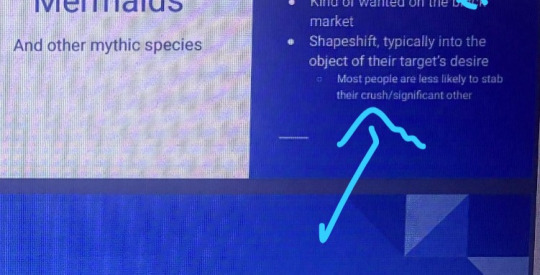
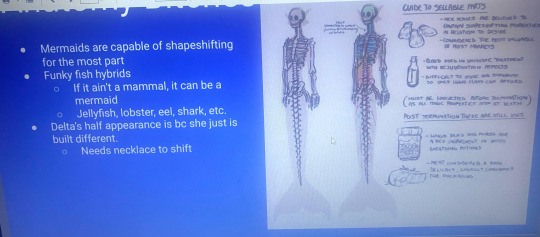
Above: Screenshots taken from the "Ocean Idiots for Idiots" slideshow by melodyofthevoid on pages 50-51.
Shapeshifting waterpeople are very common and numerous. The slideshow also claims that they require necklaces to shapeshift which is similar to the motif of many shapeshifting waterpeople requiring a talisman like the Irish merrows who require a certain hat called a cohuleen druith to do so. However, the theme of the necklace may be reminiscent to the kelpies of Scottish folklore, horses who live in aquatic environments and may assume humanoid form. A folktale from Barra in the Outer Hebrides related how a kelpie-man turned back into his equine form upon the removal of his necklace or bridle as a kelpie's shapeshifting ability was said to stem from its bridle. Some finstances in regards to how waterpeople may turn into objects as claimed in the slideshow, if I assume correctly, may be correspondent to the freshwater-poeple called the dracae from Scottish folklore or the dracs from French folklore who may assume humanoid form, but can also turn into anything their victim may desire like golden sundry and of course they may turn into wooden dishware even. I mean, who would not want wooden dishware?! It's so useful for many things.
Now, we shall dive into some more darker waters for a section, so please heed caution. It is quite the rough and stormy ocean fin terms of topics like cruelty, exploitation, dissection and some violence, especially since its tides stem from historical sources...

Above: Screenshots of "The Dismemberment Song" animatic by shandzii
Waterpeople, as claimed in the slideshow, are hunted by the forbidden market. Alleged historical records of waterpeople in regards to that show it in clear waters. Like Heather, so-called waterfolk hunters or butchers have already existed for long and I mean those who want to study or dissect them and so on and so forth. I do not refer to waterfolk-hunters who desperately want to sight and capture a waterperson upon being solely offered a reward, yet this motif may be somewhat similar to how Delta got captured in the first tide in "The Dismemberment Song" animatic with a Wanted Poster and a bounty possibly. Such "hunts" have been abundant, an official mermaid hunt was declared in Kiryat Yam in 2009 or another official one fin-cludes the mermaid hunt of the Isle of Man in 1961 according to "Merpeople: A Human History" by Vaughn Scribner on page 206. Fin such, usually a large sum of money would be declared even if one million, the price for the one who would be able to prove the existence of or capture the waterperson. Many assume such hunts solely have their origins in the means of tourist attraction. According to "Merpeople: A Human History" by Vaughn Scribner on page 105, in the year of 1749, Carl Linnaeus had read newspaper articles of waterfolk sightings from Nyköping in Sweden and sent a letter to the Swedish Academy of Science. He wanted to declare a hunt to "catch this animal alive or in spirits" for "in his mind, the reward outweighed the risk, as the discovery of such a rare phenomenon 'could result in one of the biggest discoveries that the Academy could possibly achieve and for which the whole world should thank the Academy'. Perhaps these creatures could reveal humankind's origins?". A mile off Exmouth in the 13th August of 1812, the certain Mr. Toupin and his crew sighted a supposed mermaid. It was said that "(..) a medical gentleman of Exeter has offered a reward of 20 pounds to whoever may succeed in catching the animal, and will bring it to him for dissection. In consequence of this, all the fishermen are very busy in making preparations to endeavour to entangle in their nets this fair nymph of the ocean". Whether this actually happened is a mystery. However, in the aforementioned sightings of legged waterpeople in Exeter, some sighted waterpeople would be hunted or at least chased until they would be dead and their corpse would be exploited.

In regards to Heather, I specifically refer to certain fin-atics who want to dissect or capture waterpeople in a more "professional" tide by making profit of any sort from them. The waterpeople in this work are hunted fin order for the parts of theirs to be sold on the forbidden market for all the supposed healing or magical properties they are said to have, which I fin-d is somewhat similar to the Japanese folktales of the ningyo 人魚 who had been hunted by mortal people for their healing properties. The flesh of the ningyo was said to cause youth and immortality. Ningyo blood was said to heal any wound according to "Encyclopedia of Fairies in World Folklore and Mythology" by Theresa Bane on page 249. The waterpeople in this literary work share almost the same properties of ningyo. Hoax ningyo specimens like Feeje mermaids were originally also manufactured by the Japanese and are still attributed with healing properties, despite only being usually sewn together with the top half of a monkey and the lower half of a fish. Ningyo bones are described to possess healing properties such as prevention from getting sick, stopping bloody bowel discharges as it's claimed in the "Bencao gangmu" from the 16th century, the "Compendium of Materia Medica", or such bones being used as an antidote in the Netherlands as it's said in the "Wakan sansai zue" in 1713. In the 14th April of 1222, a supposed ningyo washed up on Hakata Bay on the island of Kyushu. It was declared that the ningyo was a good omen and the bones of the alleged ningyo corpse were buried at the Ukimido temple. Around the Edo period, the bones were unearthed and soaked into the waters of the temple where bathers could absorb the supposed healing properties of sickness prevention. Scholars from the Edo period would also consume powdered ningyo bones, thinking it would extend their lives. A recorded fin-stance from 1906 told of the certain Rosa Stanley who charged Mrs. Merrit of Mulberry in Indiana large sum of money for some mermaid skin that could supposedly heal the cancer of hers. It turned into a fin-teresting situation with court dealings which one shall read in the source I shall provide in a separate entry. Skins of waterpeople are also used for many other things. According to "Legends and Superstitions of the Sea and Sailors" by Fletscher S. Bassett on page 169, "(Petrus) Gyllius says the skin of sea men taken in Dalmatia is so though that it is used for saddle covers".
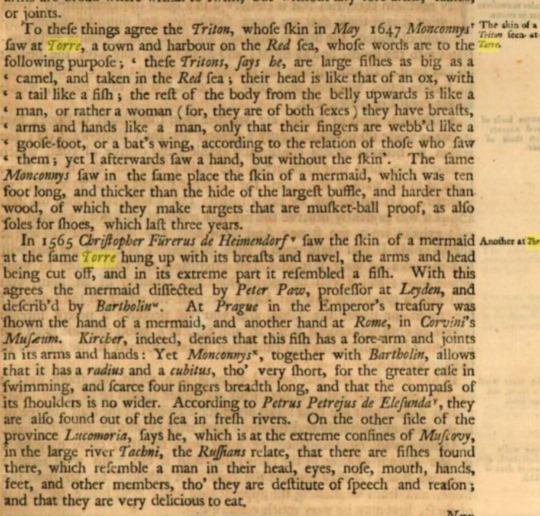
Another account which tells how the town of Torre at the Red Sea would use mermaid skin for shoe soles or targets "that are musket-ball proof" stems from "Acta Germanica; or, The Literary memoirs of Germany" on page 171. "The Triton, whose skin in May 1647 Monconnys saw at Torre, a town and harbour on the Red sea, whose words are to the following purpose; ‘these Tritons, says he, are large fishes as big as a camel and taken in the Red sea (...). The same Monconnys saw in the same place the skin of a mermaid, which was ten foot long, and thicker than the hide of the largest buffle, and harder than wood, of which they make targets that are musket-ball proof, as also soles for shoes, which last three years". The so-called Petrus Petrejus de Elesunda also mentioned in the account how in the province Lucomoria at the extreme confines of Muscovy, there are freshwater-people who are "very delicious to eat". This alongside shows how the ningyo were also prepared as dishes which corresponds to how the flesh of the waterfolk in this literary work, as claimed in the slideshow, is a "rare delicacy".
Now, I dive into the dissections of waterfolk. Aside from all those hoaxes of supposed specimens of waterpeople like the Feeje mermaids who have been dissected, some sea-cretive ones persist. A fin-stance stems from the year of 1560 in which some fishermen once caught seven mermen fincluding mermaids "on the western coast of the island of Ceylon", off the southeast tip of India according to "Merpeople: A Human History" by Vaughn Scribner on page 66. Some Jesuit priests and some certain "F. Hen. Henriques, and Dimas Bosquez physicians to the viceroy of Goa" were some trustworthy witnesses, apparently. Those physicians examined the merpeople "with a great deal of care, and made dissection thereof". Supposedly, "all the parts of both internal and external were found perfectly conformable to those of men".
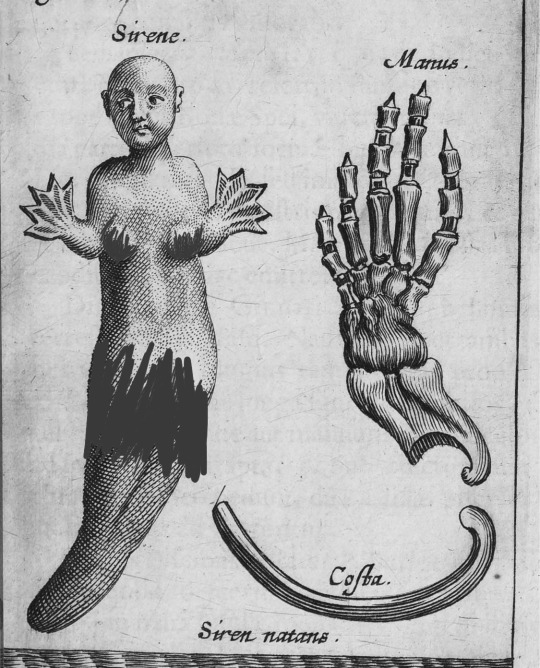
Above: Edited illustration in "Historiarum anatomicarum rariorum" in 1654.
Heather also kept a waterperson in a tank in the Animal Cann!bal animatic which is a similar motif found in the mermaid of Amboina sighting. Samuel Fallours claimed that he "had this Syrene alive for four days in (his) house at Ambon in a tub of water" according to Vaughn Scribner's work on page 106. Heather is in the possession of many waterfolk parts and puts these on display in a private collection. Vaughn Scribner tells in his "Merpeople: A Human History" on page 79 that "these were not the full, intact and scientifically studied creatures that their eighteenth and nineteenth century successors boasted. Nevertheless, by the end of the seventeenth century, mermaid hands, skins and occasionally full specimens became popular features of private collections and public exhibits". On page 80, he claims that "private collectors, (...), spent the seventeenth century scouring the globe for physical mer-specimens". As an example, in 1638, John Tradescant had "the hand of a mermaid" in his private museum in London. Thomas Bartholin held a supposed skeleton hand and the rib bones of a mermaid in his collection while he also claimed to have dissected a mermaid in Leiden which he featured in his "Historiarum anatomicarum rariorum" in 1654.
"Acta Germanica; or, The Literary memoirs of Germany" on page 171 asserts that "at Prague in the Emperor's Treasury was shown the hand of a mermaid, and another hand in Rome, in Corvini's museum". According to Vaughn Scribner's work on pages 81-82, the Royal Society of London's member Nehemiah Grew recorded in the "Catalogue & Description of the Natural and Artificial Rarities Belonging to the Royal Society and Preserved at Gresham College" in chapter one "the Rib of A Triton or Mareman. About the same length with that of a Mans, but thicker and stronger; and nothing near so much bended. (...) A Bone said to be taken out of a Maremaids Head. It is in bigness and shape not much unlike that called Lapis Manati, but the knobs and hollows thereof are somewhat different".

Above: Illustration from "The Life of P. T. Barnum" on page 233 in 1855.
Entire displayed waterfolk specimens like those that Heather had alongside are plenty as hoaxes like the Feeje mermaids or possible cases of sirenomelia. Many would purchase such faked specimens of waterpeople and, for finstance, display them and charge for money if one wanted to sea the supposed specimen. Such also happened to be exhibited of-fish-ially in museums. As related by Vaughn Scribner in pages 137-138 in his work, an infamous case was of Captain Eades' mermaid who lured with her siren song audiences of London in 1822. While he was in Batavia, the Dutch East Indies, during a trade deal, he was captivated by a dried mermaid so much so that he sold his entire ship and its contents. He believed the hoax that some Japanese fishermen had caught that mermaid, but yet his mermaid did become fin-famous in London, so it may have paid off. In spite of that, some supposed specimens are still mysteries. The sighted waterperson of Exeter in the November of 1737 who had been eliminated was also put on display in Exeter and then in London, but not a fellow has any idea whether it actually happened. The beheaded Tanagran triton in Greek mythology was also said to have been beheaded and displayed in the town of Tanagra. These are all just some fin-stances.

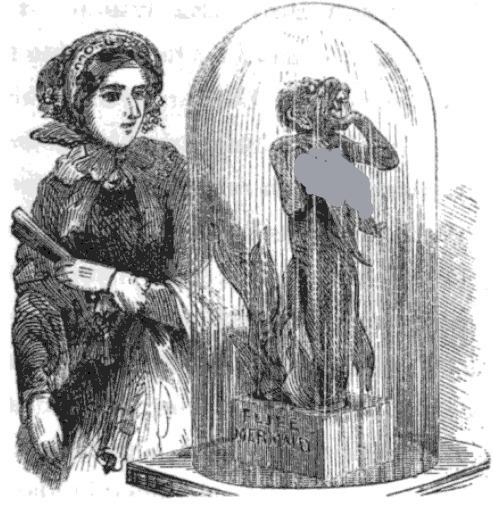
On the left above: Gif by shandzii in "The Dismemberment Song" animatic and on the right above: Edited illustration from "Sights in Boston and Suburbs, or Guide to the Stranger" in 1857.
Some claim to have purchased living waterpeople. Samuel Fallours' son had purchased the mermaid and brought it to him from the nearby island of Buru for "two ells of cloth" according to Vaughn Scribner's retelling in his work on the same aforementioned page.
Mariza encounters a lunar deity named Samira in the "Ship in a Bottle" animatic. Samira also was in a relationship with the previous oceanic deity Indra according to the slideshow. This may fin-dicate waterfolk's connection to the moon, especially lunar cycles since the moon fin-fluences the tides of the oceans and thus all marine life. Many waterpeople have more direct connections to the moon such some seal-people who could often only appear during nights such as when a full moon was present. Atargartis aka. Derceto is also said to be a goddess of the moon. Avatea or Vatea's eyes were also said to represent the sun and the moon.

Resonates with me in some tide. Screenshot taken from the "Ocean Idiots for Idiots" slideshow by melodyofthevoid on page 56.
Mariza is the humanoid oceanic deity in contrast to Larus who is the aerial deity as an avian humanoid. They are described as "siblings", but this is not in the literal sense. Larus only considers Mariza a sister. This connection, yet parallel between the aerial avian and the aquatic piscine can be somewhat distinguished in the Abgal or Apkallu. They could either appear with piscine or avian attributes, thus be considered as piscine and or either avian humanoids. The seirenes of Greek mythology would also be a well example for they were once considered to be avian humanoids and later on piscine through many shifts, especially when they were reinterpreted by Christianity. While these possible water-people that I mentioned are seen as being both at the same time´throughout history by having their names attributed to both the avian and the piscine, still and all, the direct comparison or distinction between the aerial and the aquatic in humanoid beings, the avian and the piscine, thus is an ancient concept, despite all of them not being separate deities directly like it is shown between Mariza and Larus. Atargatis or Derceto may be of mention alongside since one of her symbols was said to be the dove. In the general tide, this distinction shows the duality of air and water.
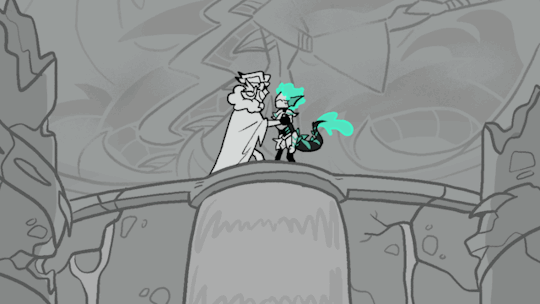

On the left above: GIF from the "It's Tough to be A God" animatic by shandzii and on the right above: Screenshot of an answered ask request on shandzii's tumblr.
All digital sources will be separate in a reblog of mine of this entry since I feel like it could be fine to be separate for this entry.
Thanks for diving into my sea alongside :>
Edits: Changed in the first phrases "well-known" to " popular"*
#ocean idiots#mariza#merfolk#merpeople#shandzii#larus#delta#waterfolkology#literary waterfolkology#mermaid#mermaids#merman#mermen#mythology#folklore#one cannot fathom how much i liked to dive finto this#i wish-fished to finclude more puns but it would get overflooded#i needs to balance the aquatic puns... blubb
9 notes
·
View notes
Text

[oc] the arrival
(or: images taken seconds before disaster)
35 notes
·
View notes
Text

Also to add with the response, the ref of Larus full body
@slightlyvindicatedmst3kfan

Larus is the embodiment of [REDACTED]
#bunbunresponds#su au#my art stuff#my artwork#Larus#drider#my dumbass thought that drider and strider where the same thing once#also spoiler thing obviously
8 notes
·
View notes
Text

another crumb
2K notes
·
View notes
Text
great shearwaters (ardenna gravis), sooty shearwaters (ardenna grisea), european herring gulls (larus argentatus) and great black-backed gulls (larus marinus) scavenging from a trawler, ireland
#procellariiformes#procellariidae#ardenna#great shearwater#sooty shearwater#charadriiformes#laridae#larus#herring gull#european herring gull#great black backed gull#seabirds#tubenose#gulls#birds#birdwatching#bird photography#display flight#BOOO TRAWLERS but there were SO MANY BIRDS#this video barely shows half of it tbh#splashes are dolphins btw
32 notes
·
View notes
Text


Drawings of Larus... my baby girl who is the most politest of seagulls.
#she lives on isla rasa with 38947238 of her closest Heermann's gull friends :)#twwm#esk#larus#what if i posted drawings of my OCs more often#drawing stuff
21 notes
·
View notes
Text
Khora's birthday doodles 🎉


65 notes
·
View notes
Text
Splatmeshi Captain 3, Agent 4, and Agent 8!!


Bonus poptart and larus comic:

#splatoon#callie cuttlefish#splatoon 3#callie splatoon#squid sisters#agent 3#captain 3#splatmeshi#agent 4#agent 8#poptart#larus#splatoon oc#so sorry ive been kinda slow on the posts#i started playing monster hunter and its eating away my life force#paleoart#t rex
70 notes
·
View notes